Feeding your child is one of the most basic ways you can bond, and yet can become the one most challenging aspects of parenting for many adoptive families.
In this three-part series, Speech Therapist Melissa Pouncey will provide practical places to start working towards peaceful and healthy eating habits, along with more therapeutic information regarding feeding disorders.

Part 1: Begin with Basics
Part 2: Oral Motor Differences and Feeding
Part 3: Feeding Therapy and Finding the Right Fit
In the first post, we talked about practical strategies for improving the feeding environment for a child that may be experiencing a feeding disorder.
While many children who have trouble eating are labeled as “picky eaters”, in actuality, many children have functional or sensory oral motor differences that may make eating challenging. Oral motor differences may be either genetically or environmentally caused. In either case, assessment and treatment by a speech or occupational therapist will be necessary.
This section will discuss general oral motor differences from a developmental perspective and how they can be identified, as well as a foundational strategy for treatment.
Your mouth has two main jobs: drinking/eating and speaking. It is made up of many muscles that can be strong or weak. These muscles also have sensation that can be either normal or disordered. For example, say the sound “ooo” (as in “moon”) and then pretend to suck from a straw. The same muscle groups are active, and your airflow changes. The fact that you can do both of these things is truly a miracle of development that began the moment you were born.
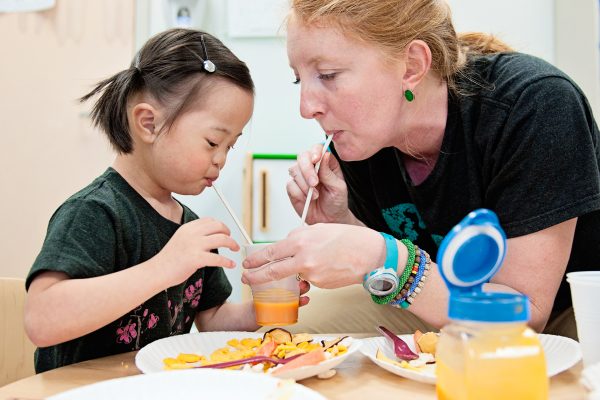
Oral motor development begins at birth. Babies need to learn to suck, swallow, and breathe in sequence. Early sucking on a bottle and slightly later, mouthing toys, builds sensory inventory inside of mouth, as well as oral motor strength. Missing out or not be able to engage in these experiences may change a child’s ability to use their sensory system typically.
When motor and/or sensory development is delayed (in the case of prematurity, cerebral palsy, and many other genetic disorders), children may have difficulty bringing toys or objects to their mouth, exploring their environment, or may have little control over holding bottle.
Similarly, children who are not given opportunities for good early feeding habits, or cannot explore environment freely experience the same lack of early oral motor development. As little ones, children are building muscle groups in lips, cheeks, and jaw. You also need these muscles groups for speech development later, so good early feeding skills are crucial.
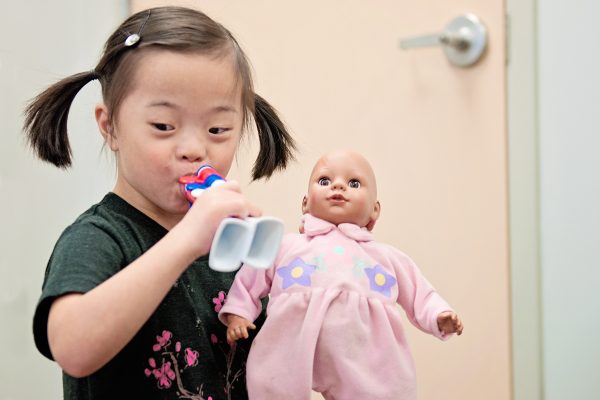
Development continues progressively as children learn to use their mouth for speech and eat more complex food, around 1-2 years in typical development. Around the same time that children use consonant sounds playfully, they begin to be able to use lips, cheeks, and tongue more skillfully. Rather than a simple up/down motion, they can move food circularly and laterally inside their mouths. If muscle groups are not used or development is interrupted, oral development can be stopped or interrupted.
Many different types of children may have naturally poor oral motor skills. Children with a diagnosis of cerebral palsy, Down syndrome, autism, developmental delay and many others, may have unique challenges in moving food in their mouths and making sounds in imitation accurately.
A common phrase in oral motor therapy is: What you see in the body is what you see in the mouth. When looking at a child’s overall body, you may be able to see difference that also exist in the structure and function of their mouth. For example, children with “low tone” in their bodies may have decreased tone in their mouths, meaning feeling where food is inside their mouth may be more difficult. Or, children with tighter muscles may also have tighter muscles in their mouth, making movement more difficult for manipulating food and making sounds.
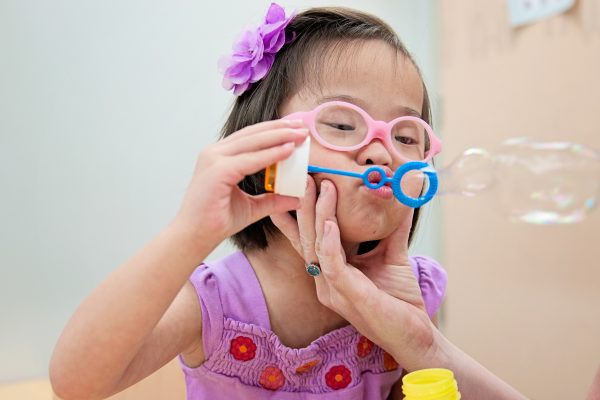
Five areas of oral skills may be impacting a child’s ability to manipulate food: jaw, lips, cheeks, tongue, and breath support.
1. Jaw: The jaw is the foundation for oral skills. Children with weak jaws may have their mouth open much of the time, and may drool more than other children do. They will have difficulty rounding lip, moving tongue, and moving air through their mouth to make speech. Chewing will also be difficult without jaw strength. Children who struggle to chew may stuff their mouth and push food back whole, or may prefer to eat textures that do not need to be chewed.
2. Cheeks: Children with weak cheeks may also have their mouths open much of the time. They may kiss with an open mouth rather than closing their mouth, and will have difficulty blowing. If cheeks have decreased strength or sensitivity, food may get lost in cheek pockets. For children that may keep food in their cheeks, choking may become a concern.
3. Lips: Children with weak lips may lose milk or food early on as they are bottle drinking. They may open- mouth kiss, not be able to close lips for sounds that use their lips (m, b, d, t), or may use flat lips when trying to blow bubbles or suck from a straw.
4. Tongue coordination: The tongue should be able to retract, extend, and move side to side easily. Some children may have difficulty moving their tongue without also moving their head. When the tongue cannot move on command or does not have coordinated movements, food cannot be moved through the mouth easily. Food may get suck on one side, or may get swallowed without being chewed. The tongue may also protrude or hang out without strength or coordination to keep it back.
5. Breath support: Children who are weak throughout their body may struggle to move air through their mouth for speech. These same children may also struggle coordinating air while drinking a bottle when there are small.
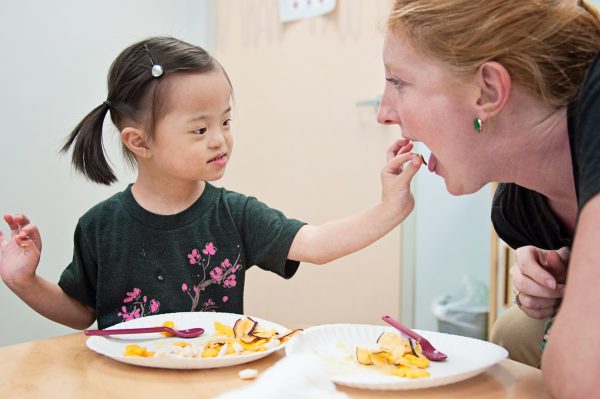
When children continue to grow without underlying oral motor deficits being addressed, feeding and speech delays may be the result. Since eating is vital to growth, anxieties or “pickiness” may develop related to an inability to manipulate food in a safe or typical way.
Speech therapy focusing on oral motor skills, along with feeding and language skills, can address the underlying causes behind what appear as anxieties. This kind of therapy will take time and trust. If you suspect your child may have oral motor deficits related to feeding, ask your pediatrician for a referral to a feeding specialist.
While you are waiting, you might begin with oral massage. There are many different oral massage techniques, but a foundation for each will be the child tolerating touch on their face. You can aid in this process by teaching your child to enjoy touch on their face, which they may not prefer. Use a firm and steady touch, which is more generally relaxing than lighter touch. Massage as often as possible, but especially before and after the child might use their mouth intensely – as with eating and brushing teeth. You might try targeting muscle groups in your child’s jaw and cheeks, as well as above their lip. Go slowly and build trust with your child, letting their pace lead the way and never pushing them to the point of being uncomfortable.
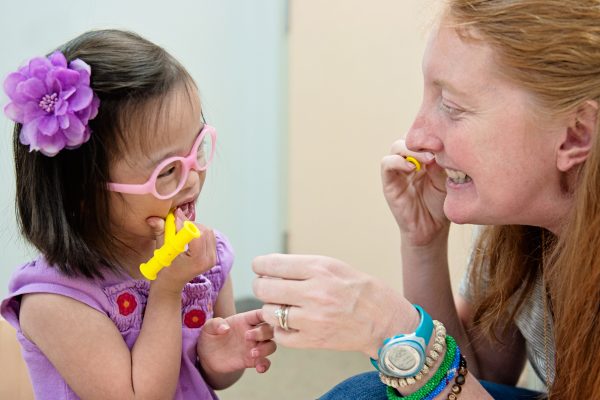
In part three of this series, we will discuss how feeding therapy might look and how to maximize success.
As always, have faith and continue to trust your child’s journey. Seeking out a professional to guide you may be the turning point.

Melissa Pouncey graduated from the University of Alabama with her MS in Communicative Disorders in 2010. She has been joyfully serving children and families with United Ability since the day after graduation in the natural environment setting, inclusive preschool, and outpatient programs. She contributed knowledge to Lifeline Children’s Services in training for social workers, and training families in Crossings. In 2016 she travelled to China with Lifeline to train caregivers in Lifeline’s foster center and several orphanages. Her specialties include international adoption, Autism, AAC for children with multiple needs, oral placement therapy for speech and feeding, and child advocacy. Melissa is state board certified as well as American Speech and Hearing Association (ASHA) certified.

























Leave a Reply